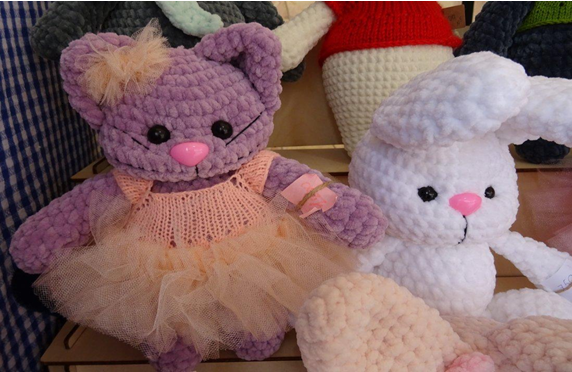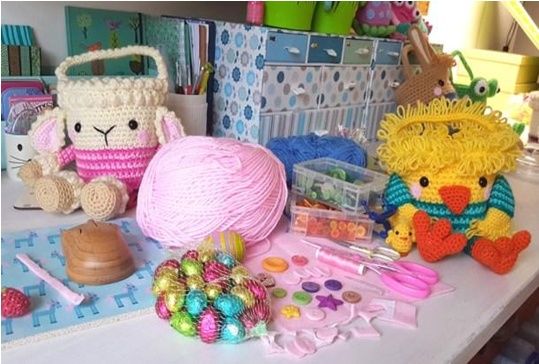How To Knit Toys
Published :
12/16/2019 09:12:33
Categories :
Advice from psychologists on raising a child
, List of all pediatricians by city
, Video tips from pediatricians
Your kid already has a full carton of toys. You like to buy them toys and watch them enjoy the toys wholeheartedly. However, do you want to make something with your own hands and give it to them?
Well, there is a way to make your children happy by giving them a knit toy that you knit yourself!
Of course, there are manufacturers that market commercially available knitted toys, and you can simply buy one, but then it wouldn’t be the same. And believe me, taking the time to knit a toy for your child and then giving it to them and watching them not part with it, is something you can't buy in any store. The feeling is just priceless!
How to knit toys?
Unlike toy sewing, which requires a piece of fabric, a pattern, and a sewing machine, knitting is entirely a manual process, requiring minimal basic knowledge of how the hooks are held. If you have such knowledge, we are sure that even if you have never knitted toys, you will do great.
Basic knitting processes for toys
Choice of yarn
There is no way to knit anything unless you have the basic material to knit it from. So the first thing you need to do is go to a nearby store and choose the right yarn for knitting a toy. As a first attempt, it is best to opt for acrylic yarn or a combination of acrylic and wool.
Hooks
Even if you have hooks at home, our advice is to buy new ones. You can find out what number you need on the yarn label (Each ball of yarn must also indicate which is the most appropriate size of knitting hook ).
Filling
Prepare the fillers in advance to fill the toy after weaving it. The most commonly used fillers are holofiber, polyester fibres, or synthetic cotton.
Accessories
A toy will not be attractive unless you decorate it with the right accessories. If you are going to knit a doll or animal, you need to buy "eyes" and maybe "noses" etc. Other accessories may be ribbons, flowers, small coloured balls, etc.
Design
It gets a little more complicated here, because if you don't have a design to follow, you will have a hard time knitting the toy. Knitting is a must, so it's a plus if you can count and follow patterns. If you are aware of how this works, finding the right design is easy. There are so many detailed patterns images and videos on the internet and you just have to browse and find a pattern and design you like.
We won't give you specific pattern and design models, as each person is aware of their knitting abilities, and each has their own vision of what kind of toy you would want to knit for your child.
However, we can give you some tips. If you are knitting a toy for the first time, it is a good idea to start with something as simple as coloured cubes, chicks, balls, or other easy-to-use toys that do not require complicated knitting.
As you become more confident, you can indulge in more sophisticated patterns such as knitted bears, bunnies, dolls, cottages, fantastic animals, and more. And if you become a master, then you can knit a whole menagerie and even grow your own small knit toy business.
Knitting
Before starting work on making a knit toy, you must remove the paper model, as you will need to follow the pattern constantly.
Start with the main circuit and then follow the diagram. If you are crocheting, mark each new row with bright coloured thread to make it easier to count the rows.
Filling
When you have finished knitting all the parts of the toy, sew them (maybe on a machine, but it is better to use a needle and sew the toy manually). Leave a small opening and fill the toy from there. When filling, it is very important to distribute the filling very evenly. It is also important not to overfill so that the toy does not become too firm. When done, sew the opening and you're almost done.
Placing the decoration and accessories
The eyes, nose, mouth, ribbons, flowers and other accessories you have purchased can either be sewn or simply glued on to the toy. If you wish, instead of buying and gluing your eyes and nose, embroider them on to the toy.
Tips for knitting toys and mistakes to avoid
Do not overfill
Too much stuffing is a common mistake many people make at the beginning. Don't do it! Apply the filler gradually and carefully, distributing it, but do not press too much material in an attempt to fill the toy even better. The toy must be well filled but remain soft so that it is comfortable for the child to play with.
Do not use cotton wool to fill, as this material sticks very quickly and the toy loses its shape.
Be careful with the size of the hooks
If you use thick crochet hooks, the knitting will become loose and when you put on the stuffing, it will start coming out through the holes after only a few days of use. To prevent this from happening, always look at what size hooks are appropriate for the yarn. (A great deal of experts even advise you to buy one size smaller hooks to make the knit even finer and tighter).
Do not use super adhesive
Wanting to glue the toy's eyes firmly on? A lot of knitters use strong adhesive, but sometimes it's not a good idea. Our advice is to either use a simple quick-release adhesive or embroider your eyes, nose, and mouth. (If you embroider them on the toy you will not worry about the child peeling off the eyes or nose and the knit toy will look good even long after your child starts playing with it).
Too heavy yarn is not suitable for hair, tail, or anything else
If you have knitted a doll, unicorn, horse, or other toy that needs a tail or hair, do not use heavy yarn to make them. If the yarn is heavy, not only will the toy not look very good, but over time the hair or tail will weigh down and the shape of the toy will fall apart. To save yourself from these troubles, use a light, thick yarn for your hair.
Thick, sturdy threads are better than thin sutures
Even if it seems that using a fine thread for the toy will be better, do not take the risk as the thin threads will break off quickly and all the work you put in to knit the toy will be in vain. Therefore, instead of doing extra work, use sturdy, thicker threads to sew the toy.
Be mindful of the amount of yarn you buy for knitting
This is also one of the basic mistakes made by beginners in knitting toys—to buy just as much yarn as it says in the description. The yarn is mostly never enough to completely knit the toy, and when you look for a new ball of the same colour, the yarn in the store turns out to be sold out. To avoid these problems, always buy extra yarn before you start knitting a toy.
How are toys knitted in handmade workshops and productions?
Of course, if everything described here seems impossible to you, you can buy a knitted toy from a boutique toy shop or search for a manufacturer that sells knitted toys commercially.
The toys that are available in boutique stores are handmade and made the way we just explained. The difference between boutique and home knitted toys is just the price and the fact that you didn't knit them yourself.
When it comes to making knitted toys in larger quantities, automated knitting machines are used for knitting. Thanks to these machines, knitted toy manufacturers can produce a wide variety of shapes, sizes, and designs of toys so that when you go to the store you can quickly and easily choose the most beautiful knitted toy for your child.
However, if we remove the presence of knitting machines in the big industries, the same steps as explained earlier are taken in knitting the toys.
Knitted toys strengthen the bond between mother and child
We live in modern times. Times in which, the market is filled with an extremely wide variety of toys for every age. And that's not bad!
However, the toys we buy for our children somehow do not carry individuality and cannot leave a lasting mark in the mind of the child. We buy and give the toy to them and they really enjoy it. But soon they are bored and want another toy.
However, a knit toy personally hand made is something completely different! It shows a personal attitude and through it you can touch the heart of your child. Because, even if it feels very small nor does it look quite like the ones in the store or in the ads, it has been made with a lot of tenderness and love especially for them.
The benefit of knitting toys is not only for the children, but also for you. Because the act of knitting itself soothes, rejoices, and recharges you with good emotions and, most of all, brings you closer to your child. During knitting, you can also include the child by showing them simple steps, asking for their opinion on the colour, accessories, or shape of the toy.




 Back
Back